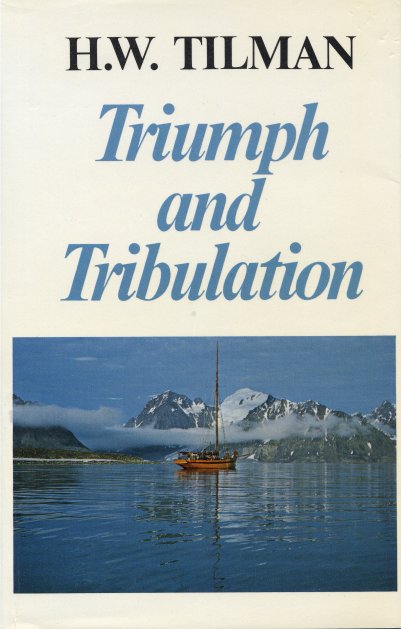 Back to Review Index
Back to Review Index
Reviewed by Paul M. Clayton
Mountain climbers and high latitude sailors share the characteristic of being impervious to discomfort. Bill Tilman is probably better known as a mountain climber but in his later years he made a number of journeys in pilot cutters to high latitude destinations. Triumph and Tribulation describes three, one to Spitzbergen, one to Greenland and one to Iceland. Each involved much tribulation and the first involved triumph. To achieve a high goal is a triumph, and Tilman set high goals for each of the three trips. In the first, he succeeded in circumnavigating Spitzbergen Island by way of Hinlopen Strait. In the second, a broken main boom ended an attempt to sail far up the west coast of Greenland. In the third, mechanical failures and recalcitrant crew brought the trip to an early end in Iceland.
Tilman has a very literate and engaging style, portraying himself with wry self-deprecation as a deaf, grouchy, superannuated curmudgeon, though his genuine affection and respect for his young crew is usually apparent (That doesn't mean he pulls his punches, especially in regards to certain members of the third crew.) After a long and engrossing passage regarding their fight to cross an icefield to reach open water, Tilman apologizes for not being able to provide photographs and notes "Pictures often tell the story better than the account, especially if the account is written by one with a limited vocabulary, a constrained mode of expression, and little or no imagination."
As anyone used to strenuous outdoor pursuit will understand, mealtimes inspire some of Tilman's sincerest rhetoric. Duffs are described as "weightily majestic" and "of noble proportions." On the other hand, there is "...dried cod, stockfish, which is eaten raw like chewing gum, only worse."
Tilman reputedly once advertised for crew, "hands wanted for long voyage in small boat; no pay, no prospects, not much pleasure." On occasion he had difficulty in finding (and keeping) crew, but on the whole he was blessed with a procession of competent able seamen. Of young Alec, cook on the third voyage, Tilman has this to say: "Life's lottery includes a great many blanks but there are yet a few prizes and I regarded Alec's fortuitous presence on board as one of them. In his early days I could fault him on only one count, a strange reluctance or shyness in the matter of duffs. We were 36 days out and west of C. Farewell before, as it were, we struck pay-dirt. One of the spotted-dog or dead-man's-leg variety, boiled in a cloth and bent at both ends to fit the pan, at last made its appearance. After that, as if a spell had been broken or a curse lifted, we had two a week, cooked in a more refined way in a basin instead of a dishcloth, and each better than the last."
Tilman and crew sailed aboard "Baroque", an ancient Bristol Channel Pilot cutter, a type known to and loved by discerning yachtsmen the world over. "Baroque" had been built in 1902. When the pilotage service converted to steam following World War I, "Baroque" and her sisters were sold off and many were converted to yachts. "Baroque" evidently spent considerable time underwater in later years and was in rough shape when Tilman acquired her. The money and time were lacking to make her right, and Tilman sailed only with fatalistic confidence. The crew evidently sailed in blind ignorance. The engine ran only sporadically, would not run in reverse at all, and would not allow the vessel to turn to port. The deck planking leaked and all the berths stayed perpetually wet. Hull planks sprang at alarming frequencies. The main boom broke, halyards and shrouds parted. Yet "Baroque" did convey her crews safely on three long voyages to high latitudes. One might note that Tom Cunliffe's "Hirta", which he used to follow the Viking route to Newfoundland, was also a Bristol Channel Pilot cutter. And with the right crew, almost any craft could, with luck, negotiate northern waters. Tilman was in Reykjavik when the "Brendan" arrived there. "Brendan" was built of alder sprigs and leather, and successfully crossed to Newfoundland under the command of Tim Severin. Tilman was a bit put out by the attention that Severin and crew received. But in the end he gave them high praise in a Tilmanesque manner by describing their journey as a "bold and remarkably uncomfortable adventure."
Ice with Everything describes three earlier voyages, including the loss of "Seabreeze" and Tilman's first voyage in "Baroque. The "Seabreeze" was driven onto a rock ledge in southeastern Greenland and Tilman characteristically uses a quotation from Dr. Johnson to explain how they ended up on ashore on a wild coast with little more than the clothes on their backs. Tilman also uses the "Seabreeze" loss to demonstrate his knowledge of the difference between flotsam and jetsam. A search of the area revealed no jetsam (the sack of provisions cast toward shore as they abandoned ship) but a valuable piece of flotsam (a pipe, as Tilman made it ashore with tobacco and dry matches). They were fortunate to be picked up by a supply boat within a few hours.
These books are long out of print, but used copies can easily be found at various bookstores on the internet, at quite reasonable prices. I am looking forward to reading more of Tilman's works. Widely available is a collection, The Seven Mountain-Travel Books, as well as Nanda Devi: Exploration and Ascent, written with his climbing partner Eric Shipton. Available but at premium rare book prices are a whole series about his voyages in "Mischief", his first pilot cutter.
Back to Review Index